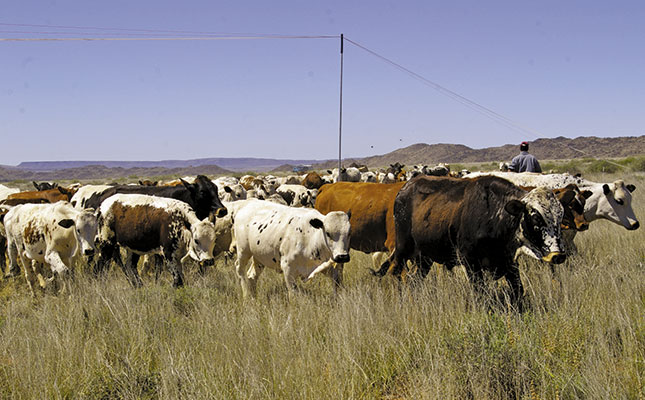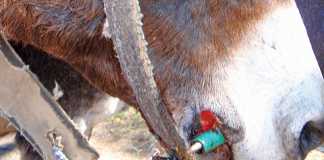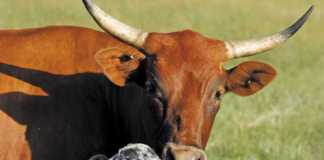
Veld management systems range from relatively simple three-camp systems to those requiring a high level of knowledge and expertise. These systems all combine the physiological needs of the plants with those of the grazing animals – a blend of controlled selective grazing and non-selective grazing. Non-selective grazing, as its name suggests, seeks to force the animals to graze all the plants in the camp by using large numbers of animals per hectare and long rest periods.
In ‘holistic resource management’, the grazing period is kept very short and hoof action is increased because of the high stocking density (as much as 400 LSU on 2ha/day). A rest period should last at least 150 days, but this will depend on the system, rainfall and carrying capacity. Ultra-high density grazing involves even higher concentrations of animals on even smaller areas for only a few hours.
One advantage of this system is that a large portion of the land is rested because the animals are crowded onto a small section for a short time. In most cases, the fewer flocks/herds and the more camps you have, the more veld can be rested at any one time. Ideally, camps should not be grazed in the same season over consecutive years. Also, grazing grassveld in the dormant season does less harm than grazing it while it is actively growing.
Here are a few systems in more detail:
Three camps – a simpel set-up
In the basic three-camp system, animals rotate through the camps slowly, with grazing periods being up to three months long and rests up to six months. A camp is only re-grazed after three years of rotation.
Group camp
Group camp systems combine the conventional and multi-camp approaches. The camps (you need at least 15) are divided into two or three groups according to veld type and grazing capacity. An entire group of camps is used or rested in such a way that each group gets rest at different times of the year over a three-year cycle.
Multi-camp
In a multi-camp system, the focus is on grazing intensity. Relatively short grazing periods of one to three weeks prevent overuse of re-growth. At least six camps per herd are needed. Some farmers follow the controlled selective grazing (CSG) approach while others prefer the non-selective grazing (NSG) method. CSG is also called high- production utilisation because of the view that it results in better animal production than NSG.
The basic principle here is that the palatable grasses are grazed only moderately while the unpalatable plants are not grazed at all and eventually die out because they are not stimulated. NSG is also known as high-utilisation grazing. Here the focus is on short grazing periods and long rests. This requires a high stocking density and many camps. NSG systems work best in homogenous veld.
High density, short duration
Here the grazing period is cut to only one to three days to increase grazing pressure. The aim is to ensure that palatable species are grazed only once during a grazing event. This system needs a large number of camps, sometimes laid out in a wagon-wheel configuration to simplify watering and stock management.
Fodder bank
The concept of giving veld a full season’s rest is gaining in popularity. This is known as the fodder flow or fodder bank grazing system. As in the group camp system, the available grazing is divided into three or four groups of camps with similar veld. Longer controlled grazing periods are used in such a way that one-third or even half of the farm can get a full growing season’s rest from the first spring growth until the first frost.
Besides providing a fodder bank, a long rest ensures that the plants and their roots have enough time to fully recover their vigour. Poorly developed root systems make veld more susceptible to moisture stress. The more homogenous and ‘sweeter’ the veld, the more merit there is in a long rest. However, some farmers are wary of rest periods that are too long. They contend that six months during the active growing season are enough.
Sources: Prof Hennie Snyman of the University of the Free State’s Department of Animal and Wildlife and Grassland Sciences; Dr Mias van der Westhuizen, Free State Department of Agriculture; Kotie van den Berg, farmer at Beeldhouersfontein, Murraysburg.













